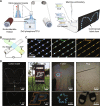Machine embroidery of light-emitting textiles with multicolor electroluminescent threads
- PMID: 38170779
- PMCID: PMC10796113
- DOI: 10.1126/sciadv.adk4295
Machine embroidery of light-emitting textiles with multicolor electroluminescent threads
Abstract
Advances in electroluminescent threads, suitable for weaving or knitting, have opened doors for the development of light-emitting textiles, driving growth in the market for flexible and wearable displays. Although direct embroidery of these textiles with custom designs and patterns could offer substantial benefits, the rigorous demands of machine embroidery challenge the integrity of these threads. Here, we present embroiderable multicolor electroluminescent threads-in blue, green, and yellow-that are compatible with standard embroidery machines. These threads can be used to stitch decorative designs onto various consumer fabrics without compromising their wear resistance or light-emitting capabilities. Demonstrations include illuminating specific messages or designs on consumer products and delivering emergency alerts on helmet liners for physical hazards. Our research delivers a comprehensive toolkit for integrating light-emitting textiles into trendy, customized crafts tailored to the unique requirements of diverse flexible and wearable displays.
Figures





References
-
- Zhang Z., Light-emitting materials for wearable electronics. Nat. Rev. Mater. 7, 839–840 (2022).
-
- Chen G., Xiao X., Zhao X., Tat T., Bick M., Chen J., Electronic textiles for wearable point-of-care systems. Chem. Rev. 122, 3259–3291 (2022). - PubMed
-
- Schlingman K., Chen Y., Carmichael R. S., Carmichael T. B., 25 years of light-emitting electrochemical cells: A flexible and stretchable perspective. Adv. Mater. 33, e2006863 (2021). - PubMed
-
- Wang L., Fu X., He J., Shi X., Chen T., Chen P., Wang B., Peng H., Application challenges in fiber and textile electronics. Adv. Mater. 32, 1901971 (2020). - PubMed
-
- Kwon S., Hwang Y. H., Nam M., Chae H., Lee H. S., Jeon Y., Lee S., Kim C. Y., Choi S., Jeong E. G., Choi K. C., Recent progress of fiber shaped lighting devices for smart display applications-a fibertronic perspective. Adv. Mater. 32, e1903488 (2020). - PubMed
LinkOut - more resources
Full Text Sources

